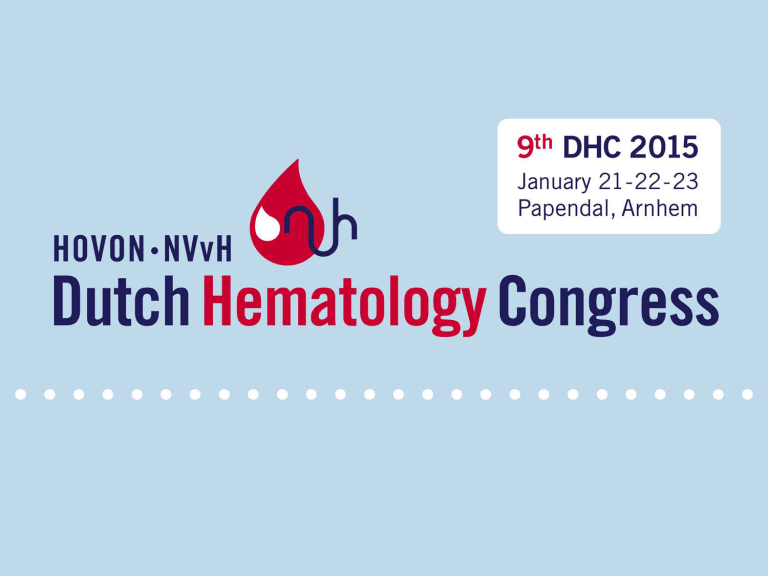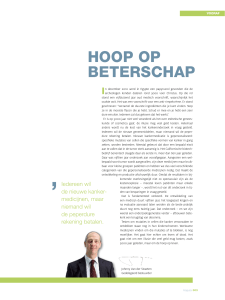
CLL: moleculaire
ontwikkelingen
Moderator
Prof.dr. J.H. Veelken
1st author / speaker
Prof.dr. Eric Eldering
Co-authors
Namen van mede-auteurs, namen van mede-auteurs,
heel veel namen van mede-auteurs
Belangenverklaring
In overeenstemming met de regels van de Inspectie van de Gezondheidszorg (IGZ)
Naam:
[ Eric Eldering ]
Organisatie:
[ AMC]
☐
Ik heb geen 'potentiële' belangenverstrengeling
Ik heb de volgende mogelijke belangenverstrengelingen:
Type van verstrengeling / financieel belang
Naam van commercieel bedrijf
Ontvangst van subsidie(s)/research ondersteuning:
Celgene, Sanofi
Ontvangst van honoraria of adviseursfee:
Lid van een commercieel gesponsord ‘speakersbureau’:
Financiële belangen in een bedrijf (aandelen of opties):
Andere ondersteuning (gelieve te specificeren):
Wetenschappelijke adviesraad:
Van microscoop naar next
generation sequencing
http://atlasgeneticsoncology.org/Reports/Ima
ges/0614AdhvaryuFig3.jpg
Stilgenbauer et al, Wiestner A Blood 2014;123:3212-3214
CLL introduction
• Heterogeneity in the clinical course is a hallmark of CLL.
• The median survival can be <3 years for patients in high-risk
subgroups and >25 years in low-risk patients.
• Priority: Understanding the biologic basis for this clinical variability
– Development of prognostic markers to dissect the heterogeneity.
– Integration in therapeutic approaches
• Established prognostic biomarkers include:
– the mutation status of the expressed immunoglobulin gene variable region
(IGHV)
– chromosomal abnormalities assessed by FISH
– expression of CD38, CD49d, and ZAP-70 by FACS
CLL introductie
• Heterogeniteit in klinisch beloop is kenmerkend voor CLL.
• Overleving kan <3 jaar zijn voor high-risk patient en >25 jaar voor lowrisk patient.
• Prioriteit: wat is de biologische basis van deze variabiliteit
– Ontwikkeling van prognostische markers voor heterogeneiteit
– Integratie in therapeutische benadering
• Bekende prognostische biomarkers:
– mutatie status van het immunoglobuline variabele regio (IGHV)
– chromosomale afwijkingen vastgesteld met FISH (17p & 11q)
– expressie van CD38, CD49d, en ZAP-70 per FACS
Vanaf 2011: CLL & de nieuwe genetica
Fabbri G, Rasi S, Rossi D, Trifonov V, Khiabanian H, Ma J, et al.
Analysis of the chronic lymphocytic leukemia coding
genome: role of NOTCH1 mutational activation. J Exp Med.
2011; 208(7): 1389-401.
Puente XS, Pinyol M, Quesada V, Conde L, Ordonez GR,
Villamor N, et al. Whole genome sequencing identifies
recurrent mutations in chronic lymphocytic leukaemia.
Nature. 2011;475(7354):101-5.
Wang L, Lawrence MS, Wan Y, Stojanov P, Sougnez C,
Stevenson K, et al. SF3B1 and other novel cancer genes in
chronic lymphocytic leukemia. N Engl J Med. 2011;
365(26):2497-506.
Quesada V, Conde L, Villamor N, Ordonez GR, Jares P,
Bassaganyas L, et al. Exome sequencing identifies recurrent
mutations of the splicing factor SF3B1 gene in chronic
lymphocytic leukemia. Nat Genet. 2012; 44(1):47-52.
Rossi D, Fangazio M, Rasi S, Vaisitti T, Monti S, Cresta S, et al.
Disruption of BIRC3 associates with fludarabine
chemorefractoriness in TP53 wild-type chronic lymphocytic
leukemia. Blood. 2012;119(12):2854-62.
Wat komt aan de orde in dit verhaal
• Landschap van de nieuwe mutaties in CLL
• Verband met klinisch beloop
−
Oorzakelijk – het geval Notch & CD20
−
Diagnostiek – nieuwe indeling
• Functies van de gemuteerde genen
−
Rol voor Sf3b1 bij DNA schade respons?
• Uitgroei/selectie van (minderheids) kloons
• Het (vervagende) onderscheid tussen
drivers en passengers
• Perspectief
Uit Landau et al Cell 2013
Landschap van mutaties in CLL voor 2011
Chemotherapie
Chemoresistentie
slechts in ~50% verklaard
door mutatie p53 of ATM
Landschap van mutaties in CLL na 2011
BIRC3
Uit Landau et al Cell 2013
De meest voorkomende nieuwe mutaties
zijn SF3B1, Notch1 en BIRC3/IAP2
• Sommige mutaties en DNA
aberraties komen vaak samen
voor, andere sluiten elkaar uit
• Duidt op synergie, resp.
functionele overlap
Sutton & Rosenquist,
Haematologica 2014
Notch1 is signalerings module
functie in ontwikkeling en differentiatie
2 bp deletie in PEST
domein van Notch
verlengt halfwaarde
tijd & signalering
Uit Landau et al Cell 2013
Notch1 mutatie verslechtert het klinisch verloop
na eerste behandeling
Kaplan-Meier curves of OS from first-line treatment.
©2012 by American Society of Hematology
Rossi D et al. Blood 2012;119:521-529
Het curieuze geval Notch1 en CD20 therapie
Rituximab heeft positief
effect bij zowel TP53 mut
als WT patient
©2014 by American Society of Hematology
Echter, Rituximab heeft
GEEN effect bij Notch1
mut patient?!
Stilgenbauer S et al. Blood 2014;123:3247-3254
Hoe komt het dat Rituximab GEEN effect heeft bij
Notch1 gemuteerde patient?
NOTCH1 Mutations Are Associated with Low CD20 Expression in
Chronic Lymphocytic Leukemia: Evidences for a NOTCH1-Mediated
Epigenetic Regulatory Mechanism
The low CD20 expression, at least in part due to HDAC-dependent
repression mechanism(s), can be reverted by HDAC inhibitor
therapy.
Blood 2014 124:296; published ahead of print December 5, 2014
Federico Pozzo,et al
Het nóg curieuzere geval SF3B1
• Hoe kan factor, betrokken bij zoiets basaals als splicing,
een pathologisch voordeel bieden voor leukemie cellen?
• Aberrante splicing van alle genen?
• Aberrante splicing van BEPAALDE genen?
• Iets geheel anders?
Alternatieve splice producten gemeten voor 3 genen
in WT, p53, ATM, SF3B1 gemuteerd CLL
ATM
FOXP1
8
8
8
WT
ALT
6
5
4
3
________
*
2
7
6
5
________
*
4
3
2
7
5
4
3
2
0
0
0
W
T
TP
A
TM 53
/1
1
SF q3B
1
1
W
T
T
A P5
TM 3
/1
1
SF q3B
1
1
W
T
A TP5
TM 3
/1
1
SF q3B
1
1
W
T
TP
A
TM 53
/1
1
SF q3B
1
________
*
6
W
T
TP
A
5
TM 3
/1
1
SF q3B
1
7
Log10 relative quantity
9
Log10 relative quantity
9
W
T
TP
A
5
TM 3
/1
1
SF q3B
1
Log10 relative quantity
ANKHD1
9
• Alternatieve splice producten verhoogd in SF3B1 mutant CLL
• Niettemin is het niveau 10-1000x lager dan WT transcripten
• Speelt dit een rol in pathogenese?
Alexander Leeksma, unpublished
Celdood inductie door fludarabine & nutlin
DNA damage
(fludarabine)
MDM2
ATM
p
p53
p
p21
puma
cell cycle arrest cytochrome c release
DNA repair
apoptosome formation
ATM gemuteerd CLL wordt gevoelig voor fludarabine
door toevoegen van MDM2 inhibitor nutlin-3a
(Kojima et al Blood 2006, Best et al Leukemia 2008)
SF3B1 gemutateerd CLL lijkt ATMmut
in respons op MDM2 inhibitor nutlin
Klonale complexiteit en selectie
• CLL niet gekarakteriseerd door specifieke DNA lesie(s)
• Diverse chromosomale afwijkingen + punt mutaties
– 13q-, tri12, 17p-, 11q-,
– p53, ATM, Notch1, SF3B1, BIRC3, MYD88,
• Diverse subkloons kunnen tegelijk voorkomen
– Selectie door biologisch voordeel
– Selectie door therapie
Sutton & Rosenquist,
Haematologica 2014
Een blik op (minieme) subkloons
Rossi et al Blood 2014
• Notch1 mutatie vroeg aanwezig in
MBL en CLL
Lionetti et al BrJH 2014 • Frequentie van de (sub) kloon
stabiel tijdens ziekte!
• Toch impact of PFS.
Het dogma van drivers & passengers in kanker
• Een aantal oncogene founder/driver mutaties treedt
vroeg op, later accumuleren ‘helper’ mutaties
Drivers & passengers kunnen van plaats wisselen!
• Elke ‘driver’ wordt ook als subkloon gevonden
• Passengers zijn al aanwezig voor drivers
• Is elke subkloon al aanwezig vóór therapie?!
– Voor Ibrutinib resistent Btk C481S: Nee! (Rossi et al Blood 2014)
Puente & Lopex-Otin, Nature Genetics 2013
Perspectief op de toekomst
• Moleculaire analyse zal betrokken worden bij:
– Diagnose
– Keuze therapie
– Relapse /resistentie analyse
• Kosten voor >10 genen panel vergelijkbaar met
FISH
• Het toverwoord ‘personalized medicine’ valt weer..
Dank voor uw aandacht
Ingrid Derks, Victor Peperzak, Marie José Kersten, Rachel
Thijssen, Eric Eldering, Erik Slinger, Martijn van Attekum,
Sanne Tonino, Dieuwertje Luijks, Rien van Oers,
Arnon Kater, Doreen te Raa
http://www.lymmcare.nl/
Notch mutated CLL resemble WT
in response to fluda & nutlin
Nieuwe diagnostische indeling
Decision tree resulting from recursive partitioning analysis and amalgamation in the training series.
©2013 by American Society of Hematology
Rossi D et al. Blood 2013;121:1403-1412
Observed OS in patients from the training series compared with the expected OS in the
matched general population.
©2013 by American Society of Hematology
Rossi D et al. Blood 2013;121:1403-1412
Incidence and distribution of gene mutations, genomic aberrations, and IGHV status for the
patients with all markers available (n = 573).
Stilgenbauer S et al. Blood 2014;123:3247-3254
©2014 by American Society of Hematology




![2 - presentatie MD. Levin [Compatibiliteitsmodus]](http://s1.studylibnl.com/store/data/000614507_1-7b9b8d09a000248fd6a38e20be466b7c-300x300.png)







